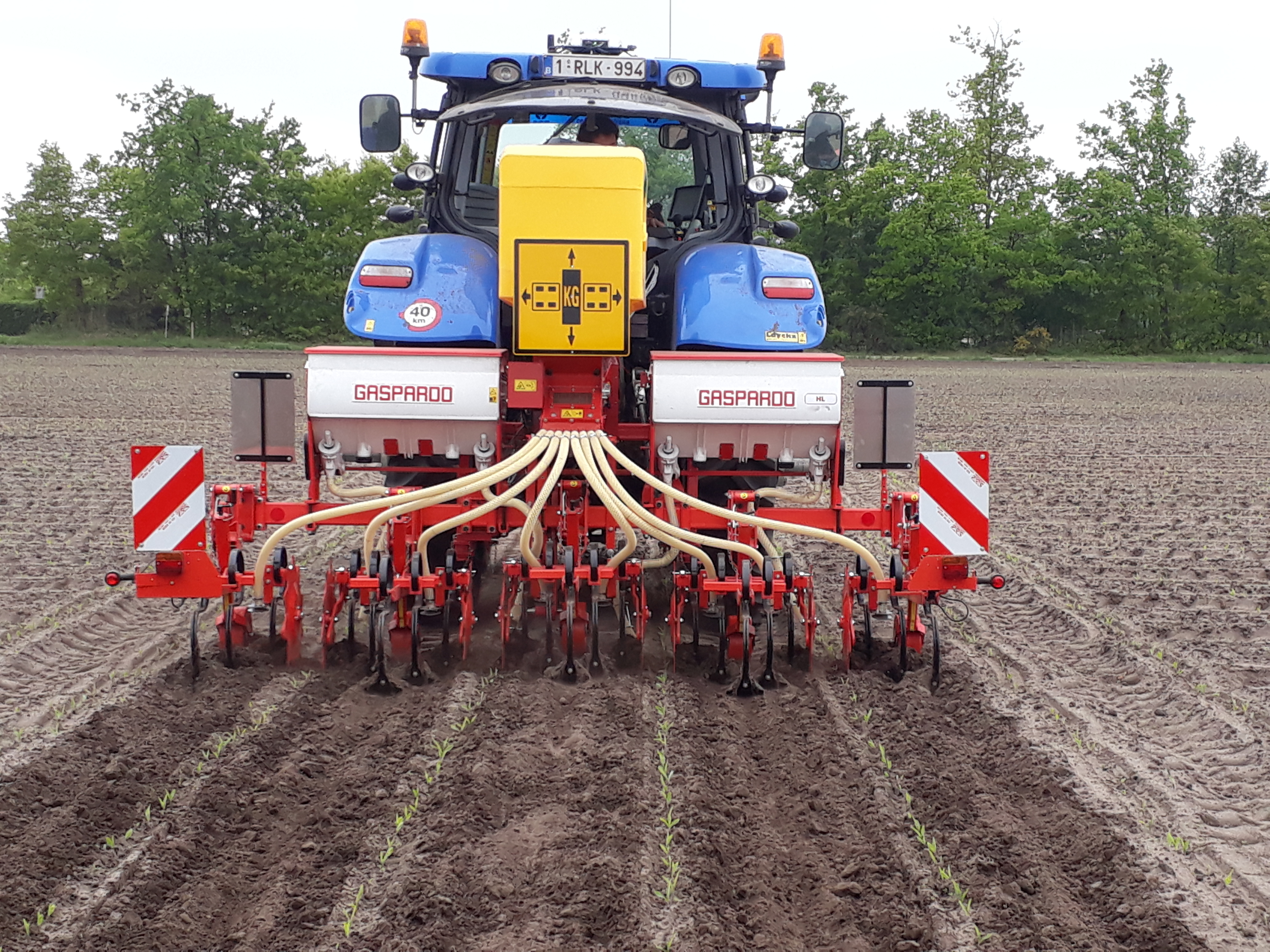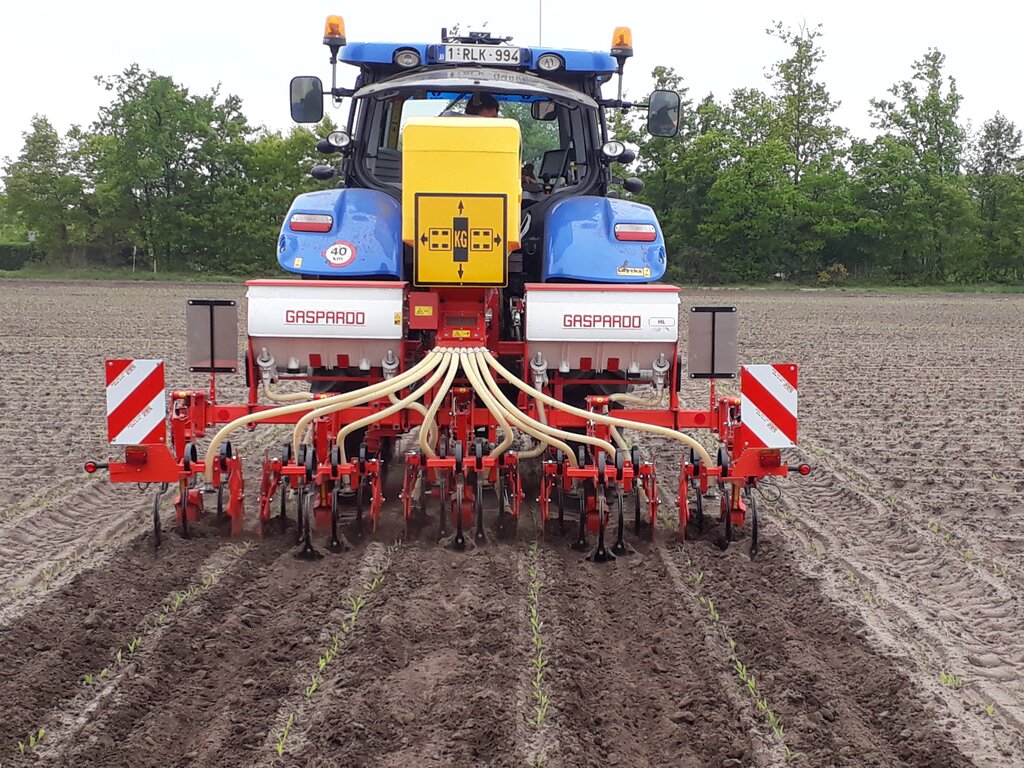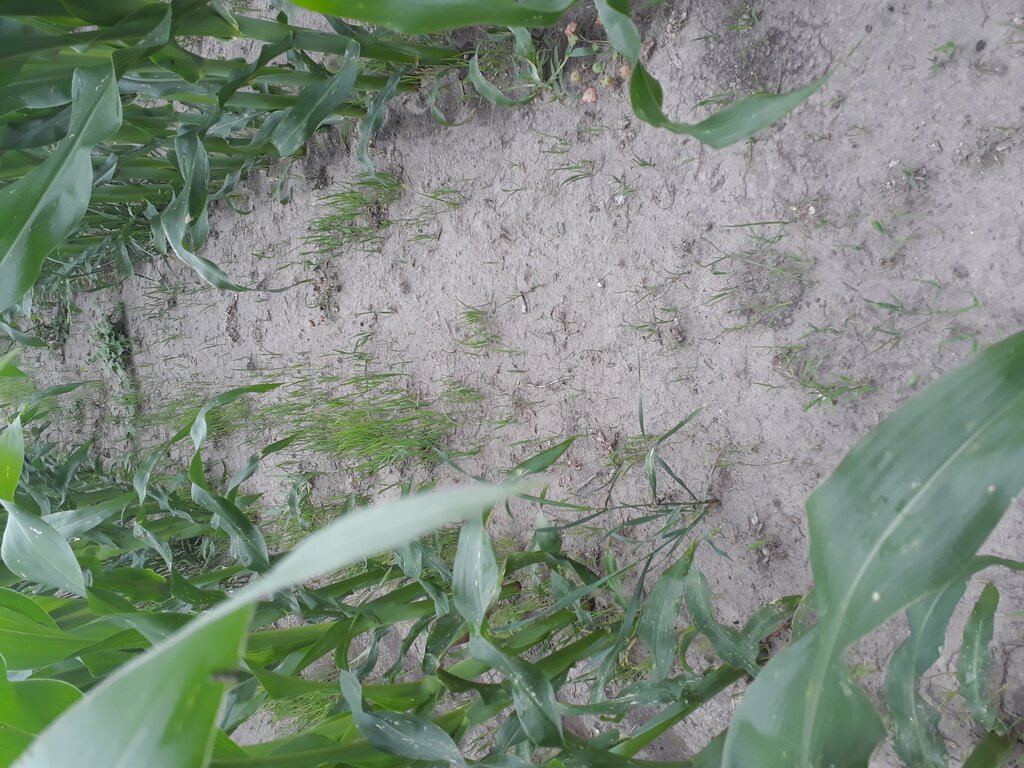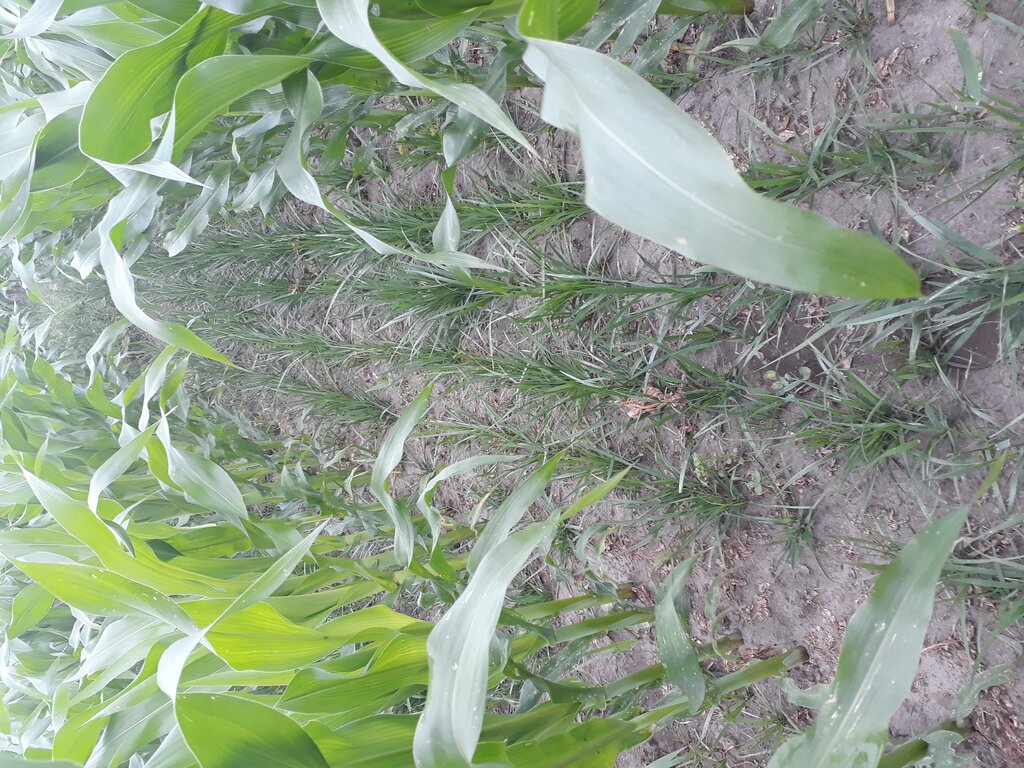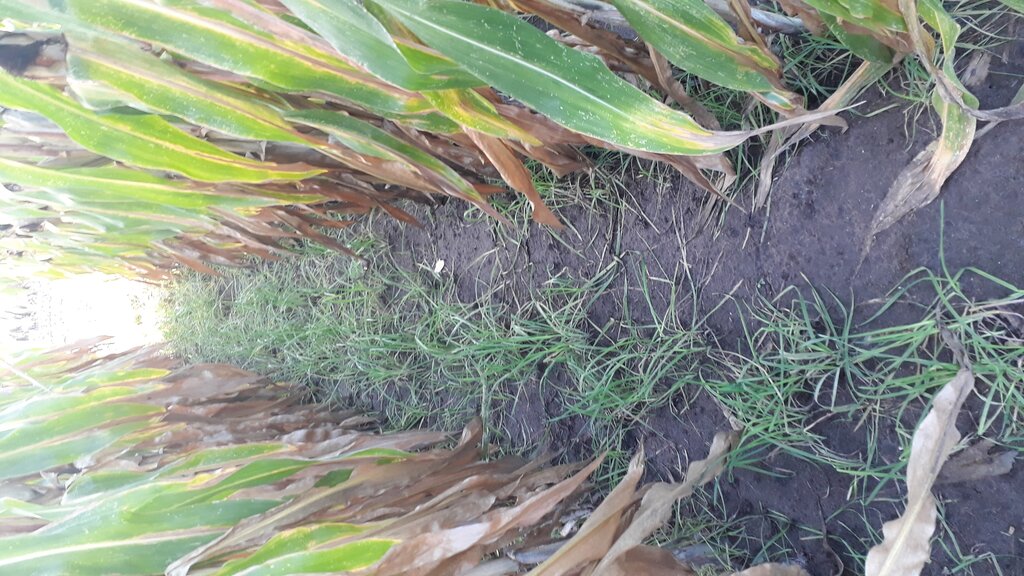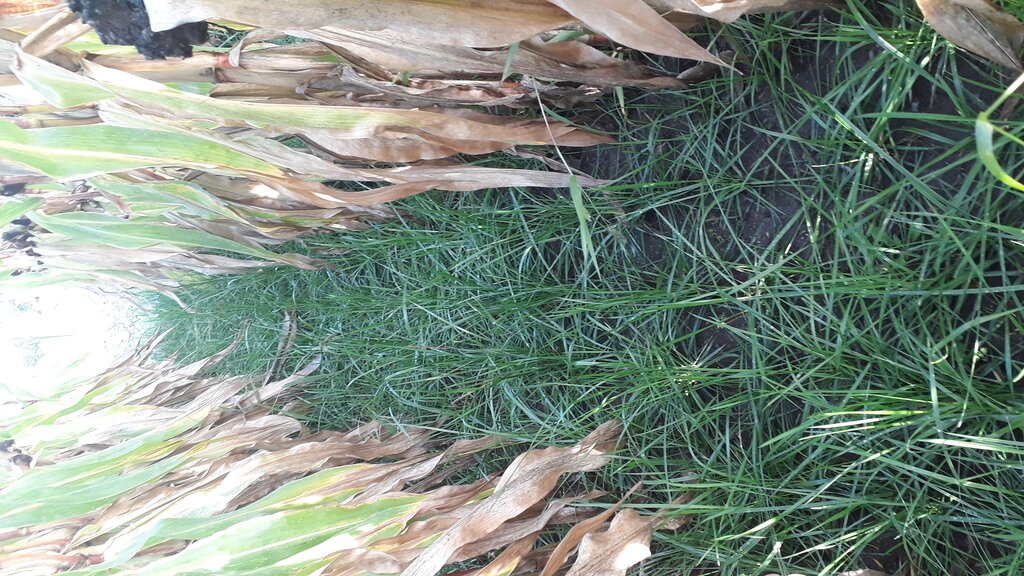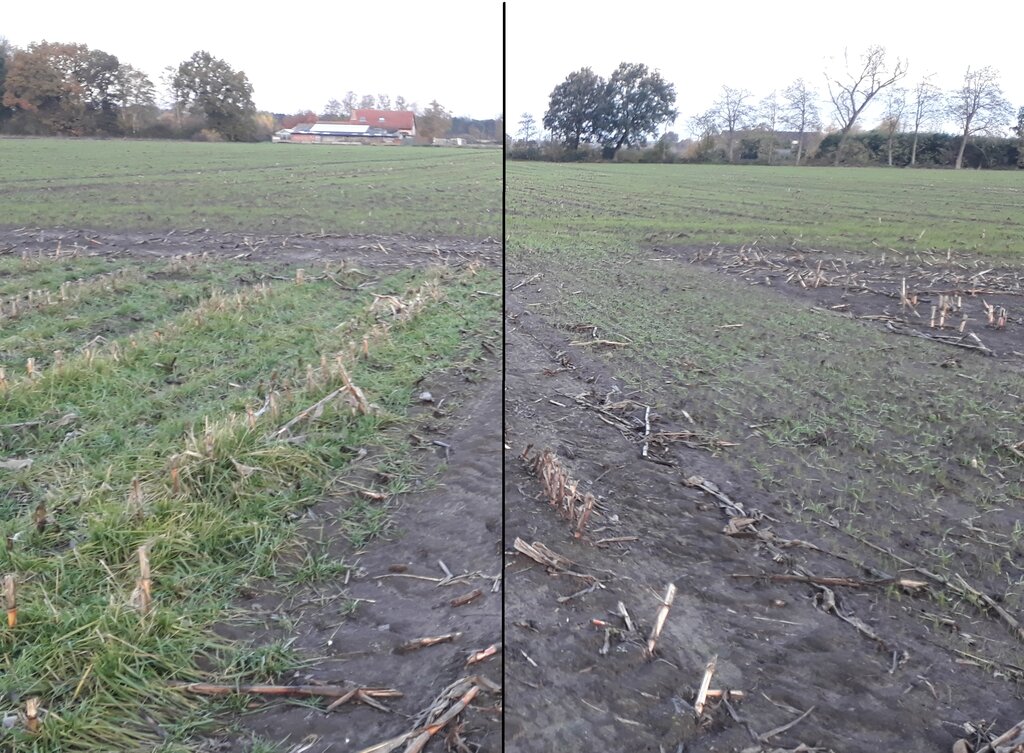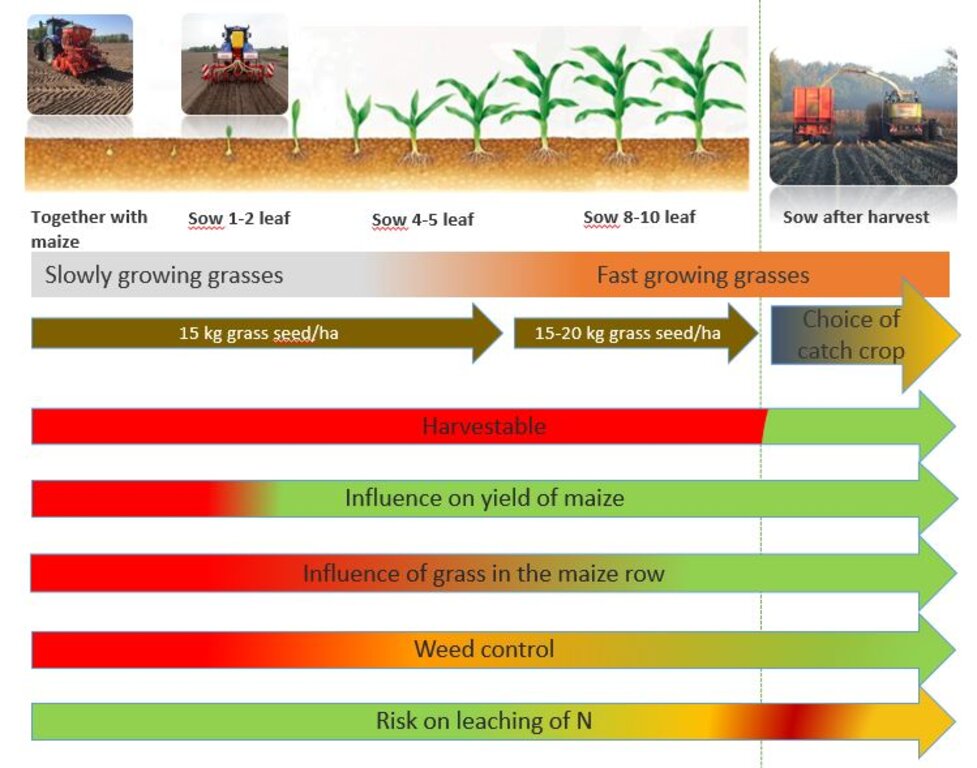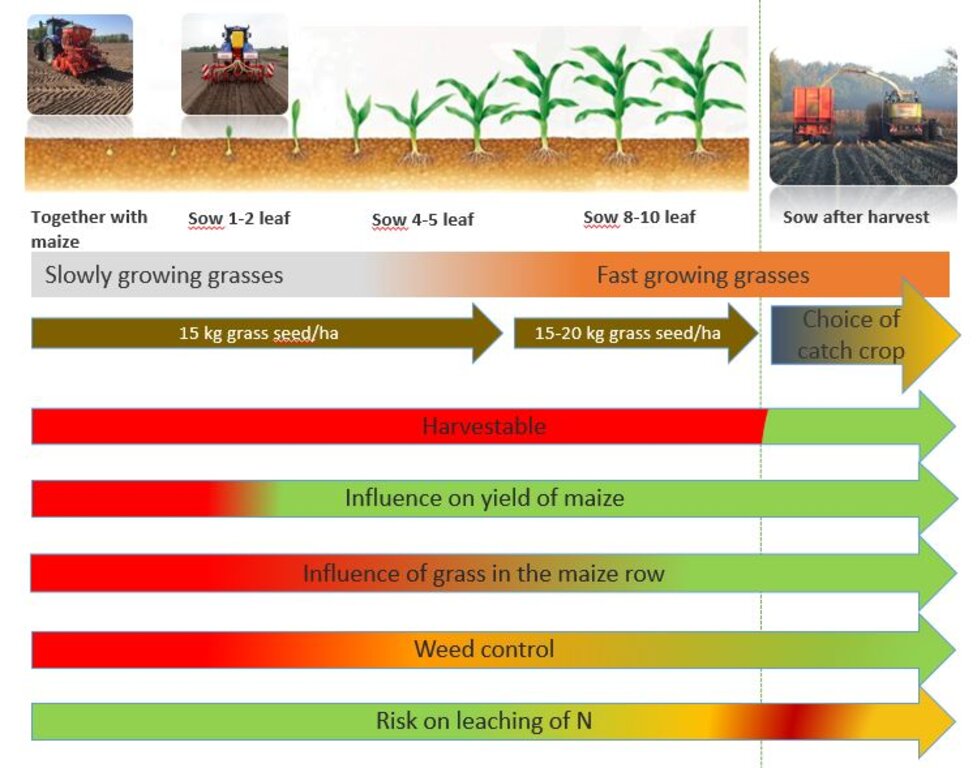Undersowing grass in maize as a cover crop [比利时]
- 创建:
- 更新:
- 编制者: Alan Radbourne
- 编辑者: –
- 审查者: William Critchley, Rima Mekdaschi Studer
Onderzaai/gelijktijdige zaai van gras in mais
technologies_6876 - 比利时
查看章节
全部展开 全部收起1. 一般信息
1.2 参与该技术评估和文件编制的资源人员和机构的联系方式
关键资源人
SLM专业人员:
Van de Ven Gert
Hooibeekhoeve
比利时
有助于对技术进行记录/评估的项目名称(如相关)
European Interreg project FABulous Farmers1.3 关于使用通过WOCAT记录的数据的条件
编制者和关键资源人员接受有关使用通过WOCAT记录数据的条件。:
是
1.4 所述技术的可持续性声明
这里所描述的技术在土地退化方面是否存在问题,导致无法被认为是一种可持续的土地管理技术?:
否
2. SLM技术的说明
2.1 技术简介
技术定义:
Undersowing of grass into maize helps prevent leaching of nitrogen in sandy soils, and keeps the soil surface covered year-round. However, the time of sowing, choice of grass variety and seeding rate are all crucial to its success.
2.2 技术的详细说明
说明:
Hooibeekhoeve (a farm education and research facility) started to experiment with undersowing in 2015. The aim was to have a well-developed catch crop/cover crop in the field during autumn and winter that could prevent nitrogen leaching. Initially, the grass was sown together with the maize, or when the maize reached the 8-10 leaf stage. But both techniques have their weaknesses and a better alternative proved to be undersowing the grass at the 4-6 leaf stage. This has been the practice since 2019, and gives the best of both worlds.
Considerations regarding time of undersowing include the following:
•Sowing at the 8-10 leaf stage is often confronted with adverse the field/weather conditions which are almost never optimal.
•Sowing together increases competition between grass and maize, and therefore lower yields of maize: however, the earlier you sow the grass, the better the effect on prevention of nitrogen leaching.
•Timing of sowing has an influence on the choice of grass and the amount of seed required:
- Early stage (simultaneous sowing and at the 1-2 leaf stage): tall fescue (Festuca arundinacea) develops and grows slowly and therefore leads to less competition with the maize: 15 kg/ha of seed is required.
- When sowing at the 4-6 leaf stage, a combination of perennial ryegrass (Lolium perenne) and cocksfoot (Dactylis glomerata) is the preferred grass mixture: again, sown at 15 kg/ha. The effect on maize yield is even positive when sowing at this stage - possibly due to the mechanical weed control, which stimulates mineralisation.
- Sowing at the 8-10 leaf stage: Italian ryegrass (Lolium multiflorum) is used at 20 kg/ha. This has the vigour to grow under the maize when maize is already tall enough tolerate this dominating grass.
The grass must be sown between, and not within the maize rows. A motorised hoe with seed box is used. This machine weeds between the rows of the maize and at the same time sows the grass. RTK-GPS tracking is needed to do this correctly.
Weed control is not an easy job in this system, and the earlier you sow the grass, the more difficult is the problem. Because there are two different crops in the field at the same time, you have to keep both in consideration when selecting plant protection products. Therefore, it is not recommended to use this technique in fields with high weed pressure, especially not where there are grassy weeds.
After the harvest, the cover crop – grass – has already formed a dense carpet. This gives protection to the soil during harvest and no further soil tillage is needed, or desirable in the autumn. The grass can then be ploughed in or killed with a herbicide in the early-spring ready for a new crop.
This undersowing technique demonstrates a decrease of N residue compared to ‘no catch/ cover crop’ and ‘sowing of catch/ cover crop after harvest’ every year and at every location. This is a positive finding. However, farmers find it hard to implement, due to the possible negative effect on the yield of the maize and difficulties with weed control.
2.3 技术照片
2.5 已应用该技术的、本评估所涵盖的国家/地区/地点
国家:
比利时
区域/州/省:
Antwerpen
具体说明该技术的分布:
- 均匀地分布在一个区域
如果不知道精确的区域,请注明大致覆盖的区域:
- 0.1-1 平方千米
技术现场是否位于永久保护区?:
否
Map
×2.6 实施日期
注明实施年份:
2015
2.7 技术介绍
详细说明该技术是如何引入的:
- 在实验/研究期间
3. SLM技术的分类
3.1 该技术的主要目的
- 减少、预防、恢复土地退化
3.2 应用该技术的当前土地利用类型
同一土地单元内混合使用的土地::
否

农田
- 一年一作
每年的生长季节数:
- 1
采用间作制度了吗?:
是
如果是,说明哪些作物是间作的:
Maize is harvested, grass is not.
采用轮作制度了吗?:
否
3.3 由于技术的实施,土地使用是否发生了变化?
由于技术的实施,土地使用是否发生了变化?:
- 否(继续问题3.4)
3.4 供水
该技术所应用土地的供水:
- 雨养
3.5 该技术所属的SLM组
- 改良的地面/植被覆盖
- 土壤肥力综合管理
3.6 包含该技术的可持续土地管理措施

农艺措施
- A1:植被和土壤覆盖层
3.7 该技术强调的主要土地退化类型

化学性土壤退化
- Cn:肥力下降和有机质含量下降(非侵蚀所致)
3.8 防止、减少或恢复土地退化
具体数量名该技术与土地退化有关的目标:
- 防止土地退化
4. 技术规范、实施活动、投入和成本
4.1 该技术的技术图纸
技术规范(与技术图纸相关):
The choice of the grass and the amount of seed is different at the various possible several stages of undersowing:
-Early stage (together and maize at the 1-2 leaf stage): tall fescue (Festuca arundinacea) was used. This grass develops and grows slowly and therefor only little competition with the maize: seeding rate = 15 kg/ha.
-4-6 leaf: a combination of English ryegrass (Lolium perenne) and cock’s foot (Dactylis glomerata) was used at 15 kg/ha.
-8-10 leaf: Italian ryegrass (Lolium multiflorum): 20 kg/ha is used. This type of grass still has the vigour to grow under the maize and the maize is already tall enough to deal with this dominating grass.
Dimensions: 75 cm between each row of maize. In between the maize are 5 rows of grass. Between the maize row and the grass is a bare soil of 12.5 cm at each side of the maize row.
In case of 4-6 or 8-10 leaf, the sowing can be combined with mechanical weed control.
作者:
Gert Van de Ven
日期:
01/07/2021
4.2 有关投入和成本计算的一般信息
具体说明成本和投入是如何计算的:
- 每个技术区域
注明尺寸和面积单位:
ha
其它/国家货币(具体说明):
Euro
如相关,注明美元与当地货币的汇率(例如1美元=79.9巴西雷亚尔):1美元=:
0.91
4.5 维护/经常性活动
| 活动 | 时间/频率 | |
|---|---|---|
| 1. | Mechanical weed control, combined with seeding of the cover crop | Dependent on the time of undersowing: together with maize, in 1-2 leaf stage, in 4-6 leaf stage or in 10-12 leaf stage (see above) |
4.6 维护/经常性活动所需要的费用和投入(每年)
| 对投入进行具体说明 | 单位 | 数量 | 单位成本 | 每项投入的总成本 | 土地使用者承担的成本% | |
|---|---|---|---|---|---|---|
| 劳动力 | Chemical weed control (product & labour) | ha | 1.0 | 70.0 | 70.0 | 100.0 |
| 设备 | Hoeing combined with sowing cover crop | euro/ha | 1.0 | 70.0 | 70.0 | 100.0 |
| 植物材料 | Seed cover crop | euro/kg | 15.0 | 25.0 | 375.0 | 100.0 |
| 技术维护所需总成本 | 515.0 | |||||
| 技术维护总成本,美元 | 565.93 | |||||
4.7 影响成本的最重要因素
描述影响成本的最决定性因素:
The way of sowing, the seed and the use of plant protection products
5. 自然和人文环境
5.1 气候
年降雨量
- < 250毫米
- 251-500毫米
- 501-750毫米
- 751-1,000毫米
- 1,001-1,500毫米
- 1,501-2,000毫米
- 2,001-3,000毫米
- 3,001-4,000毫米
- > 4,000毫米
农业气候带
- 半湿润
5.2 地形
平均坡度:
- 水平(0-2%)
- 缓降(3-5%)
- 平缓(6-10%)
- 滚坡(11-15%)
- 崎岖(16-30%)
- 陡峭(31-60%)
- 非常陡峭(>60%)
地形:
- 高原/平原
- 山脊
- 山坡
- 山地斜坡
- 麓坡
- 谷底
垂直分布带:
- 0-100 m a.s.l.
- 101-500 m a.s.l.
- 501-1,000 m a.s.l.
- 1,001-1,500 m a.s.l.
- 1,501-2,000 m a.s.l.
- 2,001-2,500 m a.s.l.
- 2,501-3,000 m a.s.l.
- 3,001-4,000 m a.s.l.
- > 4,000 m a.s.l.
说明该技术是否专门应用于:
- 不相关
5.3 土壤
平均土层深度:
- 非常浅(0-20厘米)
- 浅(21-50厘米)
- 中等深度(51-80厘米)
- 深(81-120厘米)
- 非常深(> 120厘米)
土壤质地(表土):
- 粗粒/轻(砂质)
土壤质地(地表以下> 20厘米):
- 粗粒/轻(砂质)
表土有机质:
- 中(1-3%)
5.4 水资源可用性和质量
地下水位表:
< 5米
地表水的可用性:
好
水质(未处理):
不良饮用水(需要处理)
水的盐度有问题吗?:
否
该区域正在发生洪水吗?:
否
5.5 生物多样性
物种多样性:
- 中等
栖息地多样性:
- 高
关于生物多样性的注释和进一步规范:
Hooibeekhoeve has a variety of habitat and biodiversity approaches being used and tested on the farm providing an excellent place for resilient farming and wildlife.
5.6 应用该技术的土地使用者的特征
定栖或游牧:
- 定栖的
生产系统的市场定位:
- 生计(自给)
相对财富水平:
- 平均水平
个人或集体:
- 员工(公司、政府)
机械化水平:
- 机械化/电动
性别:
- 男人
土地使用者的年龄:
- 中年人
5.7 应用该技术的土地使用者使用的平均土地面积
- < 0.5 公顷
- 0.5-1 公顷
- 1-2 公顷
- 2-5公顷
- 5-15公顷
- 15-50公顷
- 50-100公顷
- 100-500公顷
- 500-1,000公顷
- 1,000-10,000公顷
- > 10,000公顷
这被认为是小规模、中规模还是大规模的(参照当地实际情况)?:
- 中等规模的
5.8 土地所有权、土地使用权和水使用权
土地所有权:
- 州
土地使用权:
- 个人
用水权:
- 个人
土地使用权是否基于传统的法律制度?:
是
5.9 进入服务和基础设施的通道
健康:
- 贫瘠
- 适度的
- 好
教育:
- 贫瘠
- 适度的
- 好
技术援助:
- 贫瘠
- 适度的
- 好
就业(例如非农):
- 贫瘠
- 适度的
- 好
市场:
- 贫瘠
- 适度的
- 好
能源:
- 贫瘠
- 适度的
- 好
道路和交通:
- 贫瘠
- 适度的
- 好
饮用水和卫生设施:
- 贫瘠
- 适度的
- 好
金融服务:
- 贫瘠
- 适度的
- 好
6. 影响和结论性说明
6.1 该技术的现场影响
社会经济效应
生产
饲料生产
注释/具体说明:
Depends on the time of undersowing (+ in 4-leafstage)
饲料质量
产品多样性
土地管理
注释/具体说明:
More difficult in use of plant protection products (2 crops at same time in field)
收入和成本
工作量
生态影响
水循环/径流
水质
注释/具体说明:
Less leaching of N and other nutrients
土壤
土壤覆盖层
养分循环/补给
生物多样性:植被、动物
植被覆盖
生物量/地上C
注释/具体说明:
Since the cover crop can develop in better conditions, the generated biomass of the cover crop is higher compared to sowing after harvest of maize
植物多样性
减少气候和灾害风险
洪水影响
注释/具体说明:
Due to higher C-content, the soils sponginess is better. Therefore water infiltration is better and it is longer available for the crop.
干旱影响
注释/具体说明:
Due to higher C-content, the soils sponginess is better. Therefor the water infiltration is better and it is longer available for the crop
对现场影响的评估(测量)进行具体说明:
Based on expert assessment of impacts witnessed and expected outcomes.
6.2 该技术的场外影响已经显现
地下水/河流污染
注释/具体说明:
Less leaching of N and other elements
缓冲/过滤能力
注释/具体说明:
Less leaching of N and other nutrients
对场外影响(测量)的评估进行具体说明:
Based on expert assessment of impacts witnessed and expected outcomes.
6.3 技术对渐变气候以及与气候相关的极端情况/灾害的暴露和敏感性(土地使用者认为的极端情况/灾害)
渐变气候
渐变气候
| 季节 | 增加或减少 | 该技术是如何应对的? | |
|---|---|---|---|
| 年温度 | 增加 | 好 |
6.4 成本效益分析
技术收益与技术维护成本/经常性成本相比如何(从土地使用者的角度看)?
短期回报:
中性/平衡
长期回报:
稍微积极
注释:
Recurrent costs (has to be done every year).
6.5 技术采用
- 1-10%
在所有采用这项技术的人当中,有多少人是自发的,即未获得任何物质奖励/付款?:
- 91-100%
6.6 适应
最近是否对该技术进行了修改以适应不断变化的条件?:
否
6.7 该技术的优点/长处/机会
| 土地使用者眼中的长处/优势/机会 |
|---|
| More resilient to climate change |
| More resilient to plagues and diseases |
| Increase of the percentage C in the soil |
| Increased yield and income |
| 编制者或其他关键资源人员认为的长处/优势/机会 |
|---|
| Increase of the percentage C in the soil |
| Food security |
6.8 技术的弱点/缺点/风险及其克服方法
| 土地使用者认为的弱点/缺点/风险 | 如何克服它们? |
|---|---|
| Feed value of the ‘new’ crops | Analysis of the crops in standardized tables |
| More cultivation exercise necessary | Demonstrations / network sessions / literature |
| investment costs (other machinery) | NA |
7. 参考和链接
7.1 信息的方法/来源
- 实地考察、实地调查
Technique was tested in trials and fine tuned. During demonstration visits, the technique was shown to other farmers.
- 与土地使用者的访谈
Technique was developed together with other researchers on fodder crops in Flanders.
(现场)数据是什么时候汇编的?:
01/07/2021
注释:
Compiled between 2016-2021
7.3 链接到网络上的相关信息
标题/说明:
Article on use of cover crops in/after maize
URL:
1)http://www.lcvvzw.be/wp-content/uploads/2020/03/A2020_3-Vanggewassen-in-ma%C3%AFs-is-onderzaai-een-optie.pdf
标题/说明:
Article on use of cover crops in/after maize (2022)
URL:
2)https://www.lcvvzw.be/wp-content/uploads/2022/07/B2022_1-Brochure-Functionele-leidraad-groenbedekkers-bij-mais.pdf
标题/说明:
Article on this technique in grain maize
URL:
3)https://www.lcvvzw.be/wp-content/uploads/2022/04/A2022_13-Groenbedekkers-bij-korrelmais.pdf
标题/说明:
Article on undersowing after grassland tearing
URL:
4)https://www.lcvvzw.be/wp-content/uploads/2022/04/A2022_12-gelijk-en-onderzaai-bij-mais-na-gescheurd-grasland.pdf
链接和模块
全部展开 全部收起链接
无链接
模块
无模块


